University Essay: Social Stratification and Mobility Overview
VerifiedAdded on 2022/11/03
|5
|930
|361
Essay
AI Summary
This essay delves into the concept of social stratification, defining it as a form of social inequality where societies categorize members based on criteria like superiority, inferiority, and equality. It explores different types of stratification, including those based on caste, class, estate, and slavery, and relates them to the distinction between the bourgeois and working classes. The essay also examines social mobility, particularly focusing on the theory of symbolic interactionism to explain how individuals move between different social levels. Furthermore, it discusses the relationship between culture and social mobility, highlighting how cultural norms and social networks can either hinder or facilitate upward mobility. The essay references relevant literature to support its arguments, providing a comprehensive overview of the subject matter.
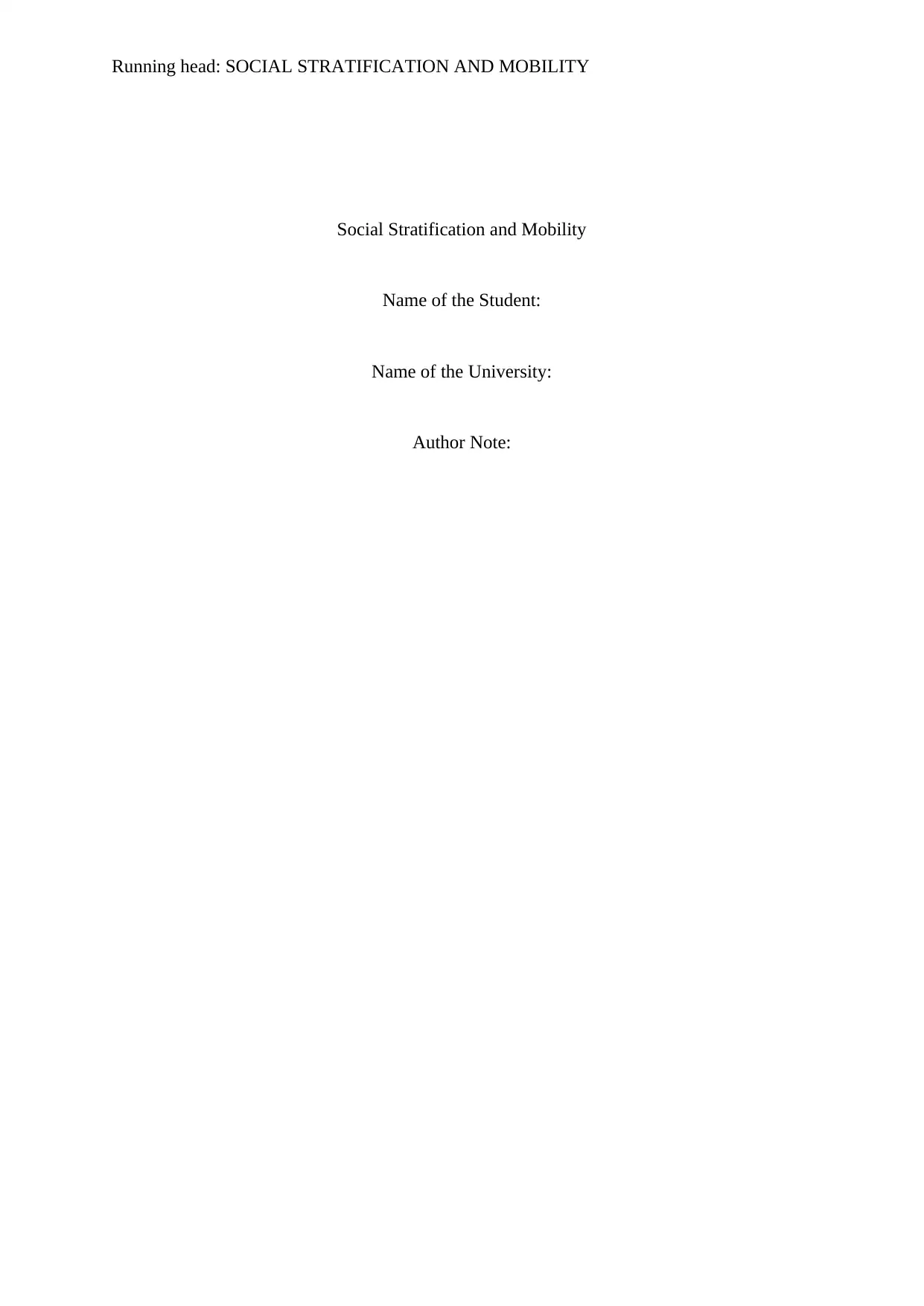
Running head: SOCIAL STRATIFICATION AND MOBILITY
Social Stratification and Mobility
Name of the Student:
Name of the University:
Author Note:
Social Stratification and Mobility
Name of the Student:
Name of the University:
Author Note:
Paraphrase This Document
Need a fresh take? Get an instant paraphrase of this document with our AI Paraphraser
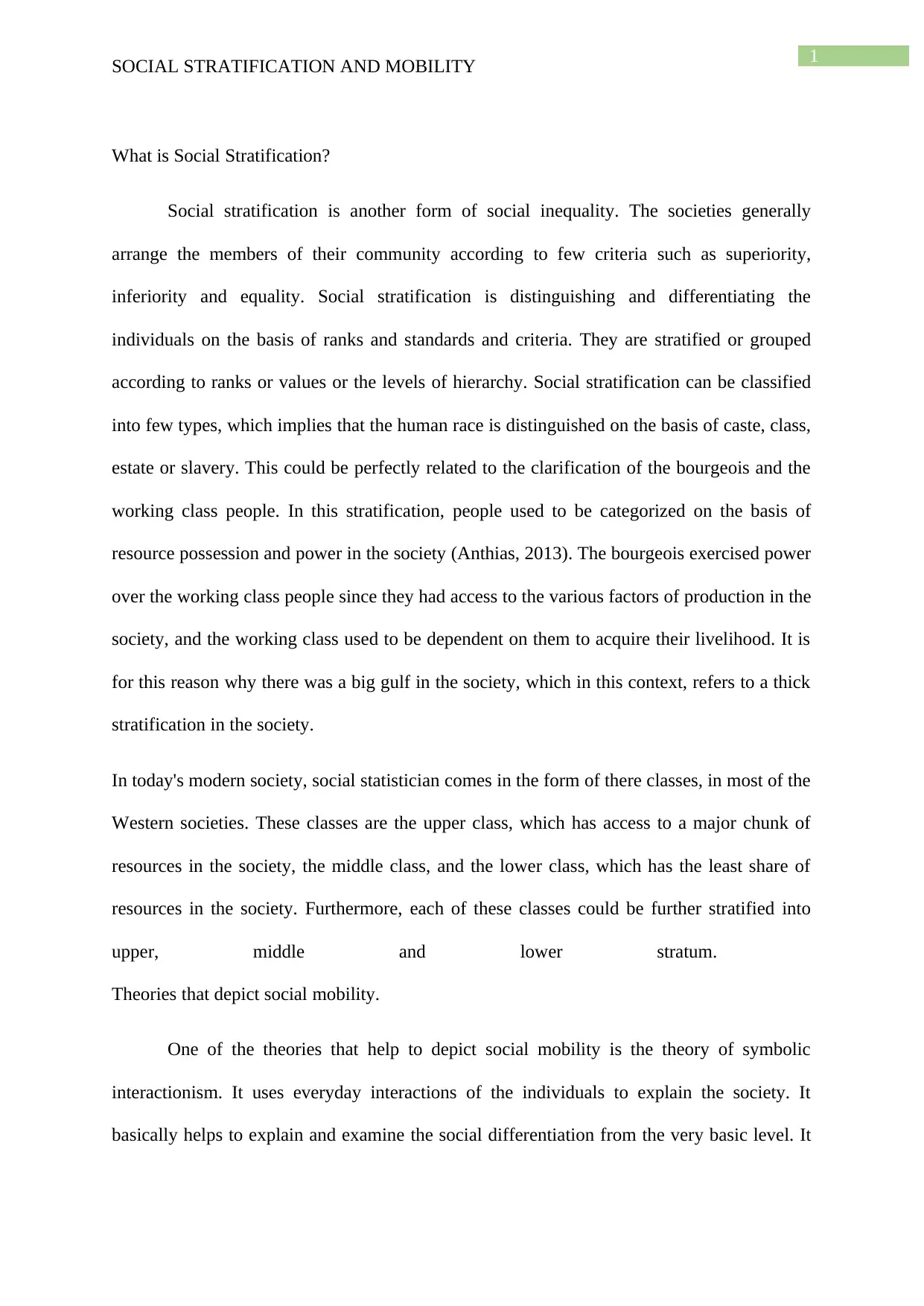
1
SOCIAL STRATIFICATION AND MOBILITY
What is Social Stratification?
Social stratification is another form of social inequality. The societies generally
arrange the members of their community according to few criteria such as superiority,
inferiority and equality. Social stratification is distinguishing and differentiating the
individuals on the basis of ranks and standards and criteria. They are stratified or grouped
according to ranks or values or the levels of hierarchy. Social stratification can be classified
into few types, which implies that the human race is distinguished on the basis of caste, class,
estate or slavery. This could be perfectly related to the clarification of the bourgeois and the
working class people. In this stratification, people used to be categorized on the basis of
resource possession and power in the society (Anthias, 2013). The bourgeois exercised power
over the working class people since they had access to the various factors of production in the
society, and the working class used to be dependent on them to acquire their livelihood. It is
for this reason why there was a big gulf in the society, which in this context, refers to a thick
stratification in the society.
In today's modern society, social statistician comes in the form of there classes, in most of the
Western societies. These classes are the upper class, which has access to a major chunk of
resources in the society, the middle class, and the lower class, which has the least share of
resources in the society. Furthermore, each of these classes could be further stratified into
upper, middle and lower stratum.
Theories that depict social mobility.
One of the theories that help to depict social mobility is the theory of symbolic
interactionism. It uses everyday interactions of the individuals to explain the society. It
basically helps to explain and examine the social differentiation from the very basic level. It
SOCIAL STRATIFICATION AND MOBILITY
What is Social Stratification?
Social stratification is another form of social inequality. The societies generally
arrange the members of their community according to few criteria such as superiority,
inferiority and equality. Social stratification is distinguishing and differentiating the
individuals on the basis of ranks and standards and criteria. They are stratified or grouped
according to ranks or values or the levels of hierarchy. Social stratification can be classified
into few types, which implies that the human race is distinguished on the basis of caste, class,
estate or slavery. This could be perfectly related to the clarification of the bourgeois and the
working class people. In this stratification, people used to be categorized on the basis of
resource possession and power in the society (Anthias, 2013). The bourgeois exercised power
over the working class people since they had access to the various factors of production in the
society, and the working class used to be dependent on them to acquire their livelihood. It is
for this reason why there was a big gulf in the society, which in this context, refers to a thick
stratification in the society.
In today's modern society, social statistician comes in the form of there classes, in most of the
Western societies. These classes are the upper class, which has access to a major chunk of
resources in the society, the middle class, and the lower class, which has the least share of
resources in the society. Furthermore, each of these classes could be further stratified into
upper, middle and lower stratum.
Theories that depict social mobility.
One of the theories that help to depict social mobility is the theory of symbolic
interactionism. It uses everyday interactions of the individuals to explain the society. It
basically helps to explain and examine the social differentiation from the very basic level. It
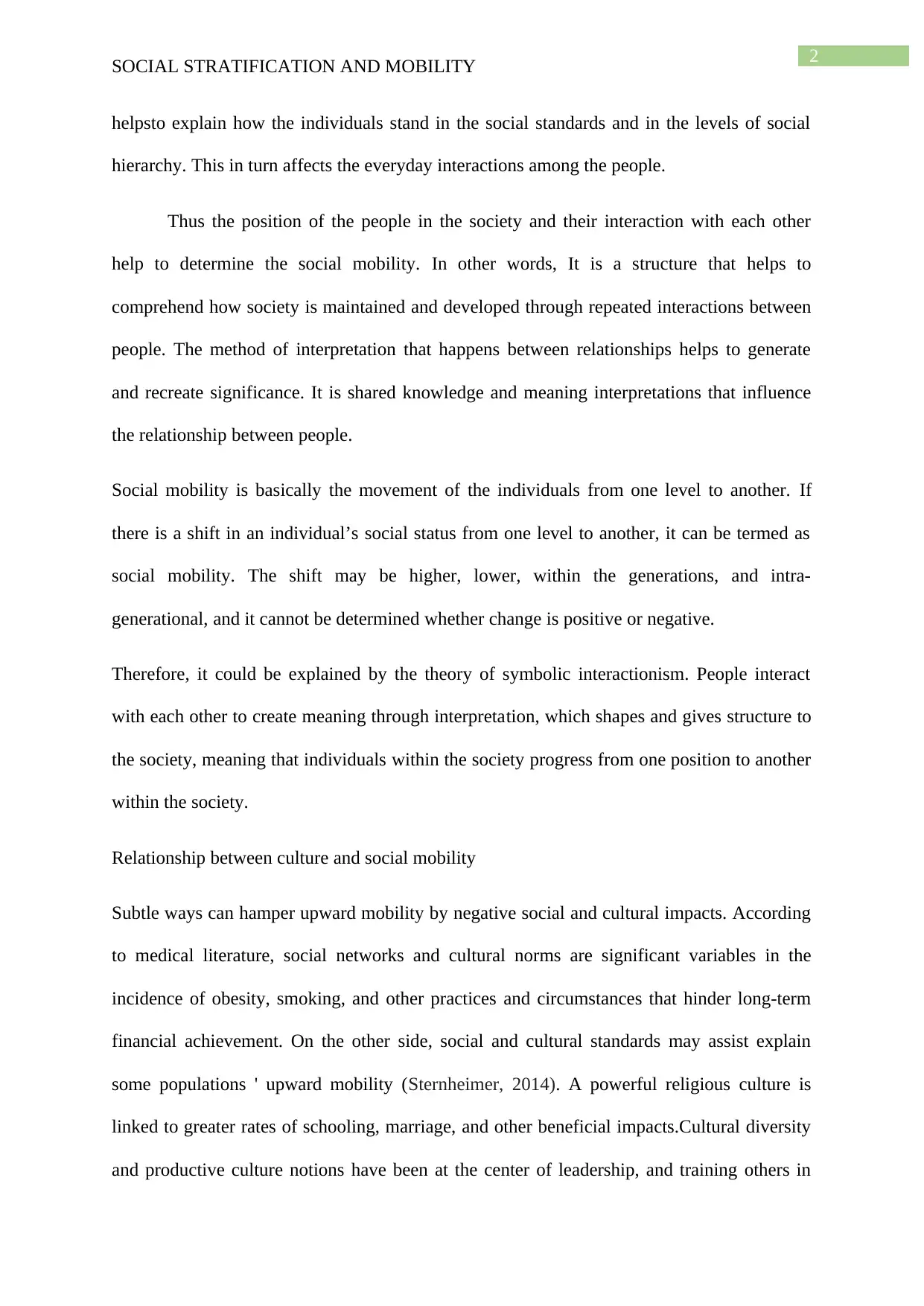
2
SOCIAL STRATIFICATION AND MOBILITY
helpsto explain how the individuals stand in the social standards and in the levels of social
hierarchy. This in turn affects the everyday interactions among the people.
Thus the position of the people in the society and their interaction with each other
help to determine the social mobility. In other words, It is a structure that helps to
comprehend how society is maintained and developed through repeated interactions between
people. The method of interpretation that happens between relationships helps to generate
and recreate significance. It is shared knowledge and meaning interpretations that influence
the relationship between people.
Social mobility is basically the movement of the individuals from one level to another. If
there is a shift in an individual’s social status from one level to another, it can be termed as
social mobility. The shift may be higher, lower, within the generations, and intra-
generational, and it cannot be determined whether change is positive or negative.
Therefore, it could be explained by the theory of symbolic interactionism. People interact
with each other to create meaning through interpretation, which shapes and gives structure to
the society, meaning that individuals within the society progress from one position to another
within the society.
Relationship between culture and social mobility
Subtle ways can hamper upward mobility by negative social and cultural impacts. According
to medical literature, social networks and cultural norms are significant variables in the
incidence of obesity, smoking, and other practices and circumstances that hinder long-term
financial achievement. On the other side, social and cultural standards may assist explain
some populations ' upward mobility (Sternheimer, 2014). A powerful religious culture is
linked to greater rates of schooling, marriage, and other beneficial impacts.Cultural diversity
and productive culture notions have been at the center of leadership, and training others in
SOCIAL STRATIFICATION AND MOBILITY
helpsto explain how the individuals stand in the social standards and in the levels of social
hierarchy. This in turn affects the everyday interactions among the people.
Thus the position of the people in the society and their interaction with each other
help to determine the social mobility. In other words, It is a structure that helps to
comprehend how society is maintained and developed through repeated interactions between
people. The method of interpretation that happens between relationships helps to generate
and recreate significance. It is shared knowledge and meaning interpretations that influence
the relationship between people.
Social mobility is basically the movement of the individuals from one level to another. If
there is a shift in an individual’s social status from one level to another, it can be termed as
social mobility. The shift may be higher, lower, within the generations, and intra-
generational, and it cannot be determined whether change is positive or negative.
Therefore, it could be explained by the theory of symbolic interactionism. People interact
with each other to create meaning through interpretation, which shapes and gives structure to
the society, meaning that individuals within the society progress from one position to another
within the society.
Relationship between culture and social mobility
Subtle ways can hamper upward mobility by negative social and cultural impacts. According
to medical literature, social networks and cultural norms are significant variables in the
incidence of obesity, smoking, and other practices and circumstances that hinder long-term
financial achievement. On the other side, social and cultural standards may assist explain
some populations ' upward mobility (Sternheimer, 2014). A powerful religious culture is
linked to greater rates of schooling, marriage, and other beneficial impacts.Cultural diversity
and productive culture notions have been at the center of leadership, and training others in
⊘ This is a preview!⊘
Do you want full access?
Subscribe today to unlock all pages.

Trusted by 1+ million students worldwide
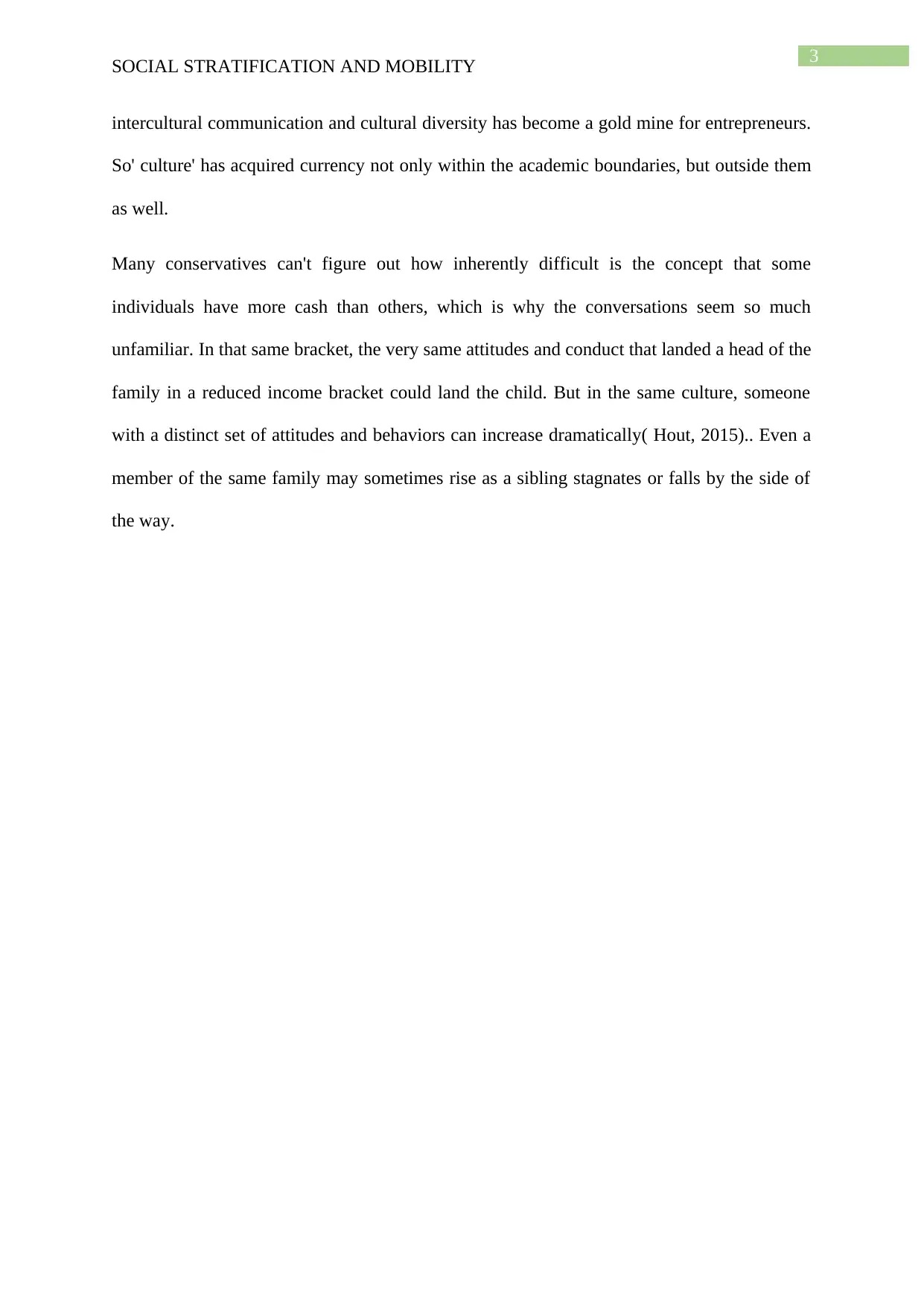
3
SOCIAL STRATIFICATION AND MOBILITY
intercultural communication and cultural diversity has become a gold mine for entrepreneurs.
So' culture' has acquired currency not only within the academic boundaries, but outside them
as well.
Many conservatives can't figure out how inherently difficult is the concept that some
individuals have more cash than others, which is why the conversations seem so much
unfamiliar. In that same bracket, the very same attitudes and conduct that landed a head of the
family in a reduced income bracket could land the child. But in the same culture, someone
with a distinct set of attitudes and behaviors can increase dramatically( Hout, 2015).. Even a
member of the same family may sometimes rise as a sibling stagnates or falls by the side of
the way.
SOCIAL STRATIFICATION AND MOBILITY
intercultural communication and cultural diversity has become a gold mine for entrepreneurs.
So' culture' has acquired currency not only within the academic boundaries, but outside them
as well.
Many conservatives can't figure out how inherently difficult is the concept that some
individuals have more cash than others, which is why the conversations seem so much
unfamiliar. In that same bracket, the very same attitudes and conduct that landed a head of the
family in a reduced income bracket could land the child. But in the same culture, someone
with a distinct set of attitudes and behaviors can increase dramatically( Hout, 2015).. Even a
member of the same family may sometimes rise as a sibling stagnates or falls by the side of
the way.
Paraphrase This Document
Need a fresh take? Get an instant paraphrase of this document with our AI Paraphraser
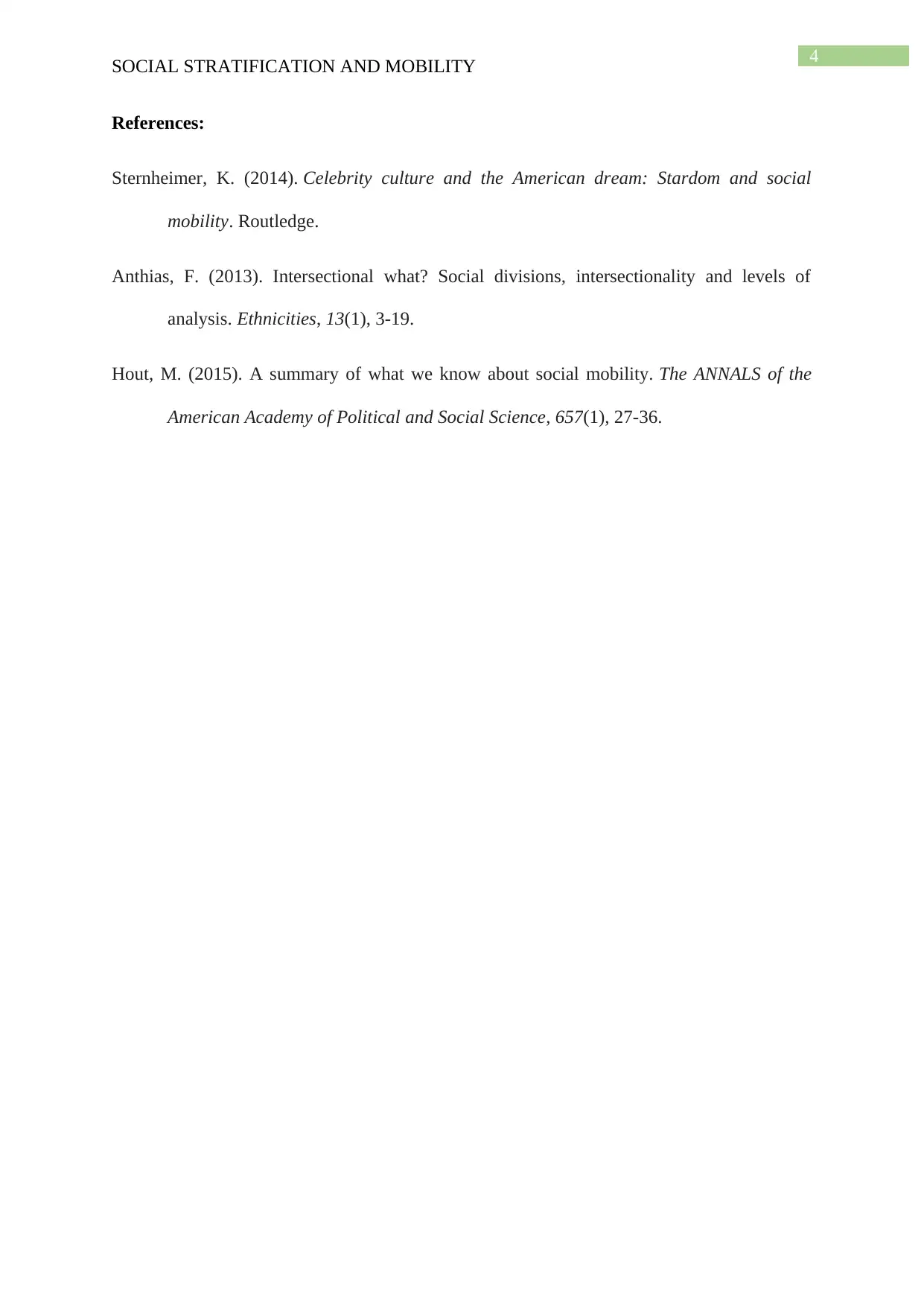
4
SOCIAL STRATIFICATION AND MOBILITY
References:
Sternheimer, K. (2014). Celebrity culture and the American dream: Stardom and social
mobility. Routledge.
Anthias, F. (2013). Intersectional what? Social divisions, intersectionality and levels of
analysis. Ethnicities, 13(1), 3-19.
Hout, M. (2015). A summary of what we know about social mobility. The ANNALS of the
American Academy of Political and Social Science, 657(1), 27-36.
SOCIAL STRATIFICATION AND MOBILITY
References:
Sternheimer, K. (2014). Celebrity culture and the American dream: Stardom and social
mobility. Routledge.
Anthias, F. (2013). Intersectional what? Social divisions, intersectionality and levels of
analysis. Ethnicities, 13(1), 3-19.
Hout, M. (2015). A summary of what we know about social mobility. The ANNALS of the
American Academy of Political and Social Science, 657(1), 27-36.
1 out of 5
Related Documents
Your All-in-One AI-Powered Toolkit for Academic Success.
+13062052269
info@desklib.com
Available 24*7 on WhatsApp / Email
![[object Object]](/_next/static/media/star-bottom.7253800d.svg)
Unlock your academic potential
Copyright © 2020–2025 A2Z Services. All Rights Reserved. Developed and managed by ZUCOL.





